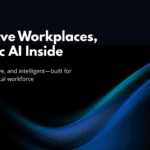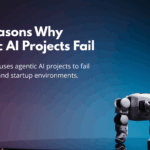Healthcare is undergoing a massive transformation with the adoption of intelligent automation. Among the most impactful innovations are agentic AI systems—AI-powered digital agents capable of autonomous decision-making, task execution, and multi-step coordination. These agents are now being deployed across various healthcare functions to improve patient outcomes, reduce clinician workload, and streamline operations. The most promising use cases are those that deliver strong returns on investment (ROI) in a short period, especially when integrated with existing hospital systems like electronic health records (EHRs). This article explores the high ROI agentic AI solutions in healthcare, outlining how each application works, the value it brings, and the kind of ROI it typically generates.
1. Clinical Documentation and Ambient Scribing
One of the most immediate wins in healthcare comes from automating clinical documentation. Physicians and clinicians often spend over 30% of their time typing or dictating notes into EHR systems, leading to fatigue, inefficiencies, and errors.
Agentic AI Solution:
Autonomous scribe agents now act as virtual assistants during patient consultations. They listen to conversations in real-time, extract relevant medical data, and generate structured clinical notes such as SOAP formats, ICD codes, and progress reports. These agents can be trained to match physician preferences and integrate directly into EHR workflows.
ROI Driver:
Saves 2–3 hours of physician time daily, reduces burnout, increases patient load capacity, and minimizes administrative errors.
Estimated ROI:
30–60% time savings per clinician, translating to $30,000–$60,000 in productivity gains annually per user. For large hospitals, ROI can reach 5x–8x within the first year.
2. Intelligent Care Coordination
Coordinating care across departments, specialties, and settings is complex. Gaps in care transitions often lead to missed follow-ups, medication errors, or hospital readmissions.
Agentic AI Solution:
AI agents monitor post-discharge patients, follow care protocols, communicate with patients via automated messaging, and schedule appointments or interventions when needed. These agents work 24/7, checking EHR updates, wearable data, and past treatment history.
ROI Driver:
Reduces readmission penalties, improves patient satisfaction scores, and supports chronic care compliance.
Estimated ROI:
Up to 20% reduction in readmissions, saving $10,000–$20,000 per patient annually in high-risk groups. ROI ranges from 4x to 6x depending on patient volume.
3. Prior Authorization and Claims Management
Prior authorization delays are a major cause of care interruptions and revenue loss. Similarly, manual claims processing is slow and error-prone.
Agentic AI Solution:
Autonomous agents complete forms, collect documents, interact with payer portals, and track claim status. They adapt to changing rules and handle exceptions without human intervention.
ROI Driver:
Accelerates payment cycles, reduces claim denials, and cuts labor costs in revenue cycle departments.
Estimated ROI:
Improves payment turnaround by 30–50%, with potential savings of $15–$25 per processed claim. ROI ranges from 6x to 10x for mid-size health systems.
4. Clinical Triage and Intake Automation
Emergency departments and telemedicine platforms are often overwhelmed with low-priority cases that could be managed more efficiently.
Agentic AI Solution:
Intelligent triage agents interact with patients using chat or voice, ask guided questions, interpret symptoms, and route the patient to the appropriate level of care (emergency, urgent care, or home care). These agents can handle thousands of interactions simultaneously.
ROI Driver:
Reduces emergency room overcrowding, shortens patient wait times, and improves the accuracy of diagnosis pathways.
Estimated ROI:
Healthcare systems report cost savings of $50–$200 per patient encounter. Annual ROI for large-scale deployment can exceed 5x in operational savings.
5. Medication Adherence and Monitoring
Non-adherence to medication is a silent problem that causes complications, re-hospitalizations, and poor chronic disease outcomes.
Agentic AI Solution:
AI agents monitor whether patients are taking prescribed medicines on time. They send reminders, educate users, log responses, and escalate to caregivers or providers in cases of continued non-compliance.
ROI Driver:
Prevents costly complications, improves medication effectiveness, and reduces provider workload for follow-ups.
Estimated ROI:
For chronic conditions like diabetes or hypertension, improved adherence can reduce hospitalizations by up to 15%. ROI is typically 3x–6x within 6–12 months.
6. Clinical Research and Trial Coordination
Clinical trials are delayed or compromised due to poor recruitment and follow-up processes.
Agentic AI Solution:
Digital agents scan EHRs to identify eligible patients for trials, handle outreach, manage consent documents, and ensure adherence to trial protocols.
ROI Driver:
Accelerates time-to-enrollment, reduces administrative burden, and enhances trial data quality.
Estimated ROI:
Faster trial completion can yield $1M+ savings for mid-sized trials. Pharmaceutical sponsors report 7x ROI on agentic recruitment tools.
7. Diagnostic Support and Reporting Assistance
Radiologists and pathologists are under pressure to interpret increasing volumes of complex imaging and lab reports.
Agentic AI Solution:
Agents assist in prioritizing imaging cases, flagging anomalies, and auto-generating structured preliminary findings that radiologists can confirm.
ROI Driver:
Boosts diagnostic throughput, improves report accuracy, and reduces time to diagnosis.
Estimated ROI:
Reduces reporting time by 20–40%, saving $50–$100 per case. For large labs, ROI exceeds 4x in the first year.
8. Patient Digital Twin Simulations
Predicting how a disease or treatment will affect an individual is still an evolving but powerful domain.
Agentic AI Solution:
Digital twin agents create real-time virtual models of patients using EHR, genomics, and lifestyle data. They simulate disease progression, suggest interventions, and test treatment plans virtually before applying them.
ROI Driver:
Prevents adverse outcomes, personalizes care, and reduces trial-and-error treatment costs.
Estimated ROI:
Still early-stage, but pilot programs show potential ROI of 2x–4x through reduced complications and shorter recovery times.
9. Virtual Nursing and Remote Monitoring
Staff shortages and growing patient loads make it hard to deliver timely nursing support, especially post-discharge or in long-term care.
Agentic AI Solution:
Virtual nursing agents offer 24×7 assistance, respond to patient queries, interpret wearable data, and escalate cases when vitals deviate from safe thresholds.
ROI Driver:
Improves patient monitoring without adding to nursing staff burden, enhances safety, and reduces unnecessary visits.
Estimated ROI:
Savings of $1,000–$2,000 per patient per year in home-based monitoring programs. ROI ranges from 4x to 7x depending on program scale.
Conclusion
The adoption of high ROI agentic AI solutions in healthcare is not just about embracing innovation—it’s about solving real business problems with measurable outcomes. From streamlining documentation to automating claims, enhancing triage, or improving care adherence, these AI-driven agents offer practical value across the board. Hospitals, payers, and health tech providers that adopt these tools wisely can achieve faster workflows, better patient experiences, and significant cost savings. As systems mature and regulatory confidence grows, high ROI agentic AI solutions in healthcare are poised to become foundational to modern healthcare delivery.
By focusing on areas that promise strong returns, organizations can ensure that their investment in AI not only improves clinical and operational efficiency but also enhances their bottom line. The future of healthcare belongs to intelligent agents—and the best returns await those who deploy them strategically.



